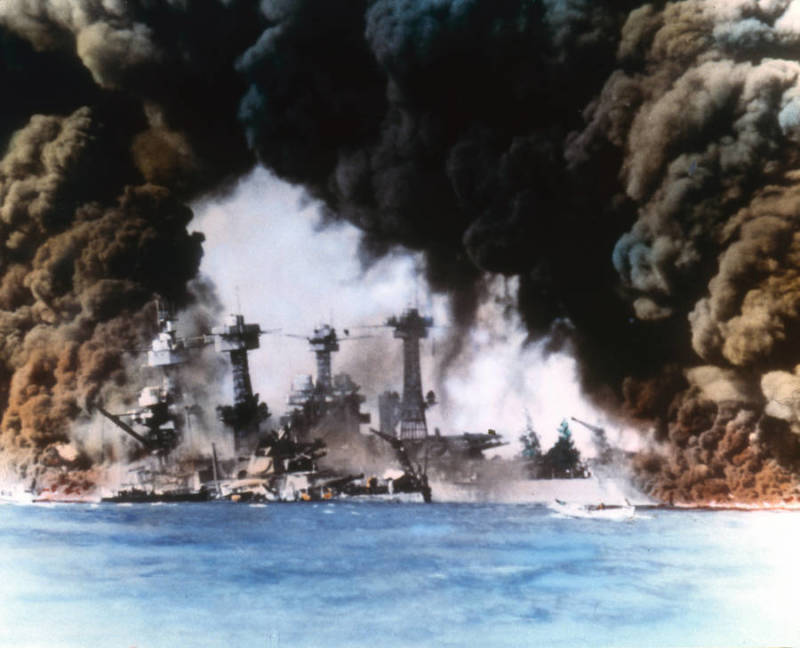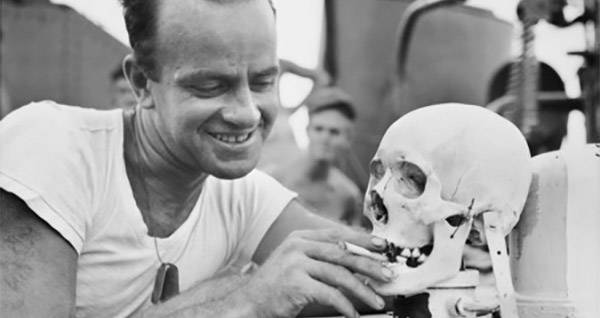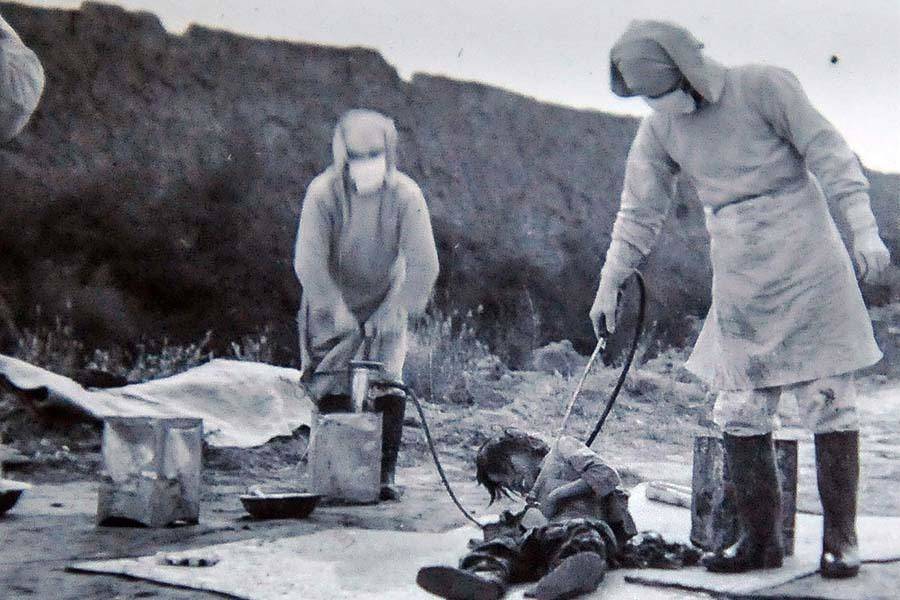While the Nazi war machine ravaged Europe, the war in the Pacific brutalized the soldiers and civilians in World War II’s often overlooked theater.
ost of what we hear about World War II is what unfurled in Europe. The movies we make and the stories we tell are almost invariably about D-Day, the Holocaust, and the Americans thwarting Nazis. The battles fought in the Pacific War are thus vastly overshadowed.
But the Pacific Theater of World War II was, in its own right, a stage for a number of brutal battles too. The casualties sustained in the Pacific Theater of World War II numbered around 36 million — about 50 percent of the war’s total casualties.
The fighting in the Pacific Theater was wrought with the same hatred, nationalism, and war criminality that raged across Europe. Perhaps it was for its raw barbarism that the Pacific War is often skimmed over in history class.
The Attack On Pearl Harbor And The Start To The Pacific War

US Navy/Interim Archives/Getty ImagesThick smoke billows from stricken American warships. From left, U.S.S. West Virginia and U.S.S. Tennessee.
The Pacific War began at sunrise on Dec. 7, 1941, when the skies above Pearl Harbor filled with hundreds of Japanese fighter planes, while simultaneously in Southeast Asia, Japan attacked multiple countries.
While America was prepared for the possibility of a Japanese attack, and in fact, over half of the public in a specified that they felt a Japanese attack was indeed imminent, they hadn’t imagined it would be at Pearl Harbor.
However, Franklin D. Roosevelt three days before the attack that Pearl Harbor was in danger. The theory is that Roosevelt ignored this 26-page memo detailing Japan’s possible motives because he wanted an excuse to enter a war against Japan.
As such, the notion that Pearl Harbor was a “surprise attack” is believed to be
Regardless, the Americans would claim that while they thought the Japanese might issue a surprise attack, they figured it would be on a colony in the South Pacific, rather in Hawaii, some 4,000 miles away.
The attack that opened the Pacific War was so unexpected to the officers at Pearl Harbor at least, that at first they didn’t even understand what was happening. One soldier, as the first bombs dropped, to a friend: “This is the best goddamn drill the Army Air Force has ever put on.”
Within minutes, a 1,800-pound bomb smashed through the U.S.S. Arizona and sent it underwater with more than 1,000 men trapped inside. Then another set of bombs took down the U.S.S. Oklahoma with 400 sailors aboard.
The entire attack was over in less than two hours, and by the time it was done, every single battleship in Pearl Harbor had sustained serious damage. American bases in Guam, Wake Island, and the Philippines were also attacked.
The United States wasn’t the only country to be attacked. The Japanese also attacked the British colonies of Malaya, Singapore, and Hong Kong, and Allied forces from the United Kingdom, New Zealand, Canada, and Australia all contributed to the fighting in the Pacific Theater.
Japan also invaded Thailand and had already stormed China, which would see the bulk of civilian casualties in the Pacific theater.
With these attacks, the U.S. entered into World War II — and they’d nearly lost their entire Pacific Fleet in the process.
It was a major victory for the Japanese. But in winning it, they awakened the enemy that would destroy them.
Indeed, after the war, the Japanese Admiral Tadaichi Hara : “We won a great tactical victory in Pearl Harbor and thereby lost the war.”
Hitler’s sweep through Europe had left Americans concerned, but Pearl Harbor gave them a reason to take action. From 1941 to 1942, enlistment numbers in the American military
Following the attack on Pearl Harbor, racial hatred for the Japanese, even if they were American citizens, burgeoned across the country.
Even TIME Magazine “Why, the yellow bastards!” and the lyrics “We’re Gonna Find A Fellow Who Is Yellow And Beat Him Red, White, And Blue” were commonly crooned.
Within two months, Japanese-Americans were rounded up and forced into internment camps. Almost overnight, some 120,000 people of Japanese ancestry were locked up purely for their heritage. By the end of the Pacific War, the Japanese would sustain the second most casualties, with over one million soldiers killed or missing.
Japanese Warfare In The Pacific War

The Pacific Theater of World War II was, as one historian put it, “hands down the war’s most hated theater in which to fight.”
And as the hundreds of thousands of American men who had just enlisted were about to learn, it was going to be more brutal than anything they would see in Europe.
That’s in part because the Japanese didn’t fight by the same rules used in Europe. They had signed the Geneva Convention in 1929 but failed to ratify it, and as such, had no incentive to treat a prisoner of war as the agreement had stipulated.
Even before America had joined the war, the Japanese had already demonstrated just how brutal they could be. They’d subjected the Chinese to the and too horrible to describe.
Their culture, at the time, was ruled by a state-controlled version of Shinto. They believed that a soldier should die honorably: surrendering was a disgrace.

US Navy/The LIFE Picture Collection/Getty ImagesSmoke from antiaircraft guns fills the sky as aircraft carrier USS Yorktown is hit by a Japanese torpedo during the Battle of Midway. Pacific Ocean. June 6, 1942.
They told their prisoners of war outright that they saw no value in their lives. One Capt. Yoshio Tsuneyoski told a group of American captives:
“We do not consider you to be prisoners of war. You are members of an inferior race, and we will treat you as we see fit. Whether you live or die is of no concern to us.”
He was echoing an order that had come straight from Tokyo. The War Ministry of Japan had explicitly told its men: “It is the aim not to allow the escape of a single one, to annihilate them all, and not to leave any traces.”
Torture And Human Experimentation

Xinhua via Getty ImagesUnit 731 personnel conduct a bacteriological trial upon a test subject in Nongan County of northeast China’s Jilin Province. November 1940.
The Chinese weren’t the only ones subjected to human experimentation by the Japanese. Some American prisoners-of-war were subjected to horrific experiments as well.
One group of soldiers who crash-landed onto Kyushu Island in 1945 were carried off by a group of Japanese soldiers who told them that they would treat their injuries. Instead, they brought them to a facility for experimentation.
One had seawater injected into his bloodstream to see how it would affect him. Another had his lung surgically removed so that the doctors could watch how it affected his respiratory system. And another died when a doctor drilled into his brain to see if it would cure epilepsy.
“The experiments had absolutely no medical merit,” an eyewitness to their deaths, Japanese doctor Toshio Tono said. “They were being used to inflict as cruel a death as possible on the prisoners.”

Xinhua via Getty ImagesA Unit 731 doctor operates on a patient that is part of a bacteriological experiment. Date unspecified.
Indeed, many more were simply subjected to the cruelest deaths possible without any attempt to disguise the torture as science.
Some prisoners reported being tied to a stake under a blazing summer sun with a glass of water just out of reach. The Japanese guards would watch and laugh as the victim struggled.
Others say they were force-fed water, then tied to the ground while guards jumped on their stomachs. Still more reported that the guards would start each day by the names of ten men who would be forced to go out and dig their own graves.


